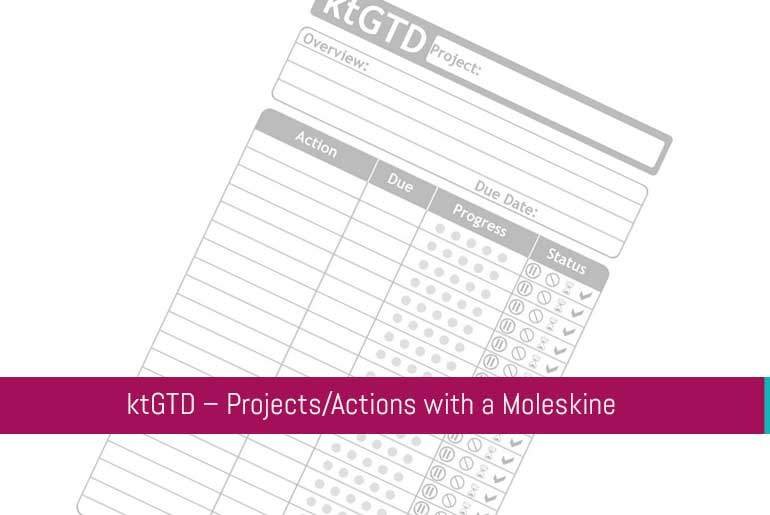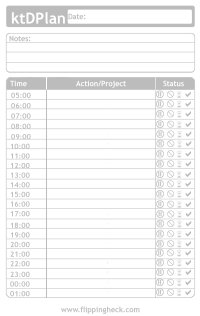Managing your time and procrastination levels with the ktDPlan
If you’re trying not to procrastinate then the ktGTD plan may help you figure out what you have to do and when.

Background
Reading “Getting things done” (affiliate link) has really changed my life. I don’t want to sound all preachy and “happy-clappy” but before I’d read the book I was a complete mess organisationally.
Allen’s approach means that all tasks, no matter how trivial are captured and moved to project lists with their next actions associated with them. I’m great at this, I capture everything! The problem I have is actually doing it.
The problem I have with GTD is that Allen is a bit vague when it comes to the “doing” part. The idea of tasks/projects being broken into actions based on context has never really clicked for me and whilst I do use them (after a fashion) everything always seems to be lumped into a huge “@computer” list which can be quite soul destroying.
Allen talks about only working on actions that fit in with:
- Context: – There’s no point trying to make a load of phone calls if you’re in a library
- Time Available – Do you really want to start that report that’ll take an hour when you only have 15 minutes?
- Energy Available – If you’re tired then you won’t get your head around that financial report now!
I agree with all of the above but I still never seem to get around to doing everything in a day that I feel I should (whether I need to do all of it is another matter!)
Because everything is in the same context, the same things seem to get pushed to the back of the queue each time thanks to the second two factors and there’s the final 4th factor which Allen left out which I think is the most important and damaging of all:
Procrastination Level
Looking at the Next Action/Context list it’s just too easy to pick simple things and ignore the real “biggies” and, as Allen is not a fan of “hard-scheduling” tasks I never feel the need to “force” myself to do them.
Previous solutions
I’ve written about this in the past when I discussed Time Management: Procrastination vs GTD and Non-Conditional Scheduling when I came up with a weekly planner in the attempt to kick myself in the backside to do stuff that I really didn’t want to do. You can download the files in two formats:
Whilst I used it, the system worked quite well and it did get the stagnating projects moving even if I really didn’t feel like doing them as I knew I’d be spending and hour on the rubbish stuff in order to work on something I knew I’d enjoy.
I was going to start using the Weekly Plan again but it doesn’t really fit in with my current system. At the time I was using an A5 filofax but with my Moleskine the A4 layout won’t really fit in. Also, as I’ve started coming up with a “design style” which was started with my “Meeting Mate” form, and also my ktGTD project forms which is available to download here:
New Solution
I’ve decided to go back to a more granular approach of planning my time, whilst every hour will probably not be accounted for as it was with the previous Weekly Planner I’m hoping that I will be able to use this approach to schedule in time to get some stagnating projects moving – at least to a point where I actively want to work on them and they will no longer have to be scheduled.
So, enter the ktDPlan (KT Daily Plan)!
How to use it
The ktDPlan is a Moleskine sized insert which lists the hour of the day, action/projects for that time frame and the status. You can stick the inserts into your Moleskine, use the pouch at the back or (as I do) leave them loose in the front.
At the top of the form there’s a notes section to enable you to jot down reminders etc. To schedule work, simply write a brief action/project description against the hour that you wish to start and then mark-off the status as you work on it. You can then use the ktGTD project forms to break down the project/actions in more detail.
The main point of this system is not to get too panicky or annoyed if something doesn’t get done at the allotted time. If you use these forms for a couple of weeks you’ll build up a picture of what you’re not doing and hopefully be able to focus and motivate yourself into getting some part of the project underway.
As always, comments are welcome!




















“One or more of the Yahoo Groups discussing GTD has been having a discussion about the usefulness of contexts for people whose jobs keep them in one place all the time. You might be interested in checking in there.You might also be interested in Mark Forster’s “”Do It Tomorrow,”” which seems very consistent with GTD but adds the concept of understanding what a day’s work should be — so you can <i>finish</i> a day’s list and get the added motivation. (Forster’s a UK author, so you should be able to get the book much easier and quicker than I did in the US.)No, GTD is not a motivational system, though a lot of us wish it were.“
“Excellent book. Great and helpful post. Thanks.Amanda http://thetimemastery.com “
“Thanks for the heads-up on the book, I’ll check it out :)”